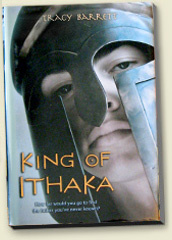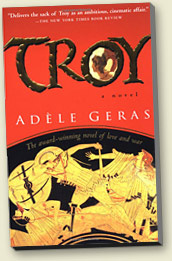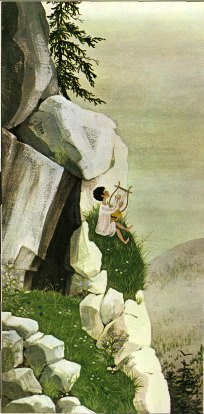| Greek
Myths and Legends in Current Literature
The impact of Greek myths and legends is evident in recently
published books for all ages and in adaptations
and renderings of the The Iliad and the The Odyssey. On this page,
several books are presented.
King of Ithaka
Author: Barrett, Tracy
Publisher: Henry Holt, 2010
Category: Middle School
 |
 |
As the bards of ancient times sang tales of the Trojan War and of Odysseus' homeward journey, so Tracy Barrett spins the tale again with her own imaginative twist. As the story opens, Odysseus' son Telemachus, in typical teenage fashion, is spending his time spying on girls with his close friend, the centaur Brax. When a ship arrives in the harbor, its passengers come to the palace, overrun with noisy suitors, and shabby from years without a king. Soon the talk turns to the missing Odysseus, with whom one of the visitors sailed. After they have eaten and the unruly suitors are beginning their evening's partying, the visitor tells Penelope and Telemachus that he hasn't seen Odysseus for seven years. After Penelope leaves the hall, the gray-eyed sailor Mentes advises Telemachus to sail to Pylos and Sparta for further word of his father. Unsure of what to do, in desperation Telemachus turns to an ancient and unpredictable Titan living deep in a cave on the island. Her words are puzzling: “Return to the place that is not, on the day that is not, bearing the thing that is not. On that day the king will return.”
So Telemachus sets off in the company of Brax and a stowaway, Polydora, escaping from a difficult situation at home. The tale is full of gripping adventure, close calls and memorable characters, but it is, most of all, Telemachus' coming of age story. He is at the center, foolish, wise, stubborn, crafty, and resilient, and in this odyssey, he is very much the hero. Barrett's retelling is revisionist, and as such, she follows in the footsteps of the ancient tellers, who before the tale was finally written down, revised and remade the story each time it was repeated to a new audience. Like the bards of old, Barrett has written a fresh version of an old tale, one that will completely engage a new audience of young readers.
— Review by Barbara Scotto.
Troy
Author: Geras, Adele
Publisher: New York, Harcourt, Inc., 2002
Category: Young Adult
 |
 |
In Troy, Adele Geras presents the siege of Troy through the eyes of Xanthe, a young servant girl who works in the Blood Room caring for wounded soldiers. She is also nursemaid to Astryanax, son of Andromache and Hector. Xanthe uses her soothing, healing powers tending to both Astryanax and battle victims, and, although she has important roles in the House of Priam, she sees herself as “nothing.” “I am as near to nothing as it’s possible to be. Men are less than Gods, and women are less than men, and poor women are less than rich women, and girls are least of all, and poor girls are even less than that. Better to be an ox” (p. 18). Even as she has these thoughts, Xanthe has already been targeted by Eros to fall in love with Alastor, a young nobleman whom she nurses in the Blood Room. Unfortunately, Eros has also marked Xanthe’s sister Marpessa, servant to Helen, as Alastor’s lover. As the city of Troy is destroyed around them, these two sisters struggle in their relationship with one another and with the power of love.
Like The Iliad, this novel takes place during the last days of the Trojan War. Through the interaction of her characters with the Gods, Geras explores the concepts of love, loyalty, courage and faith in human life in ways that will appeal to young adult readers.
— Review by Judith Malone-Neville.
The Penelopiad
Author: Atwood, Margaret
Illustrator (Cover): Nina Chakrabarti
Publisher: Canongate 2005
Category: Adult
Penelope, wife of Odysseus, has long been viewed as a clever and faithful spouse. In The Odyssey, she manages the vast estates on Ithaca, raises her son Telemachus alone, keeps numerous suitors at bay, and remains true to Odysseus during the twenty years of his absence. In The Penelopiad, Canadian writer Margaret Atwood presents a different view of the faithful Penelope. Through narrative and poetry, Atwood gives the reader a more rounded and modern woman with a complicated personal history and a critical eye. Atwood’s novel begins in Hades with a deceased Penelope telling the reader “Now that I’m dead I know everything.” The knowledge that most troubles her is the death of her twelve favorite maids at the hands of Odysseus and Telemachus. In Hades these twelve maids form a chorus that harmonizes with Penelope.
This lyrical novel gives voice to Penelope’s story in her own words. She evolves from a young girl whose father tried to kill her, to the young bride of a powerful warrior, to a mother and wife who loves, but does not completely trust, her husband, to a shadow who knows all there is to know. The relationship between Penelope and Odysseus is tenderly built on mutual story-telling with the caveat, “The two of us were—by our own admission—proficient and shameless liars of long standing. It’s a wonder either one of us believed a word the other said. But we did. Or so we told each other.”
— Review by Judith Malone-Neville.
Mythology: The Gods, Heroes, and Monsters of Ancient Greece
Author: Lady Hestia Evans (fictional)
Editor: Dugald Steer
Illustrator: Nick Harris et al
Publisher: Candlewick 2007
In 1826 Lady Hestia Evans gave a copy of Mythology, a book she had written, to her friend John Oro. John was on his way to Greece, and Lady Hestia asked him to find antiquities for a gentleman starting a museum there. With the book in hand, John traveled around the country, making notes in the margins, stuffing its pages with mementoes, and even finding some treasures – among them, an obol, a coin used to pay the ferryman who rowed the dead across the River Styx, a gold death mask from Mycenae, and even a wisp of the famed golden fleece. Unfortunately, as he traveled, he became increasingly greedy, and with impatience and haste, he begged Zeus to give him the gift he gave to Midas, the king in a myth he apparently hadn’t finished reading. Zeus complied, and all too soon, John realized the nature of his godly gift.
This story provides the frame for a rich introduction to Greek mythology, As the reader follows John Oro’s journeys, he or she is introduced to the Greek gods, their history, their power, their quirks and their failures. While some readers will wish to read this delightful tome from beginning to end, others will dip into it, reading short pieces that attract their eye. It’s a book to browse, to pore over, a book to come back to time and again. Beautifully designed to resemble an antique student’s text, the borders on the pages are friezes depicting some of the ancient stories, and the cover is studded with “gems.” Games, booklets, a fold-out map and genealogical chart, and even a Pandora’s box to open will keep young readers delightfully occupied.
— Review by Barbara Scotto.
Wise Guy: The Life and Philosophy of Socrates
Author: M. D. Usher
Illustrator: William Bramhall
Publisher: Farrar Straus Giroux 2005
Imagine Socrates as a child, precocious and loaded with curiosity. He roams the streets of Athens, listens in on conversations in the agora, and visits the workshops of his friends, the carpenter and the cobbler. All the while, his head is buzzing with questions about the meaning of wisdom, the nature of ideas and how ideas are different from tables and chairs. M. D. Usher begins his picture book biography by using Socrates’ "adult interests" . . . to imaginatively recreate his childhood in a way sure to appeal to young readers. Moving from Socrates as a child, Usher seamlessly transitions the character into the philosopher as an adult.
The witty illustrations and the lively text portray him as a man full of life, living each moment to its utmost, willing to make the best of whatever happens but unwilling to compromise his integrity regardless of circumstance. The last view of Socrates in the book shows him with his friends who have come to visit with him in prison where they dance and talk together. In the final double page spread, a parody of Raphael’s famous painting “School of Athens,” the reader will be delighted to find hilarious caricatures of many of the philosophers who have followed in Socrates’ footsteps, always asking questions.
The picture book text is a fine introduction to the philosopher for students in the early grades, but many readers, particularly those who are a bit older, will be happy to discover a second, more detailed text that exists side by side with the story. Most double pages have what resembles a scroll of paper containing information that relates to the main text, giving much greater detail about what is happening, or expanding on the philosophical ideas that have been presented. The book ends with short paragraphs about all of the philosophers in Socrates’ School of Athens pictured on the preceding page. In the paragraphs, the author, often quoting from the philosopher being described, briefly states the way each figure from Erasmus to Martin Luther King, Jr. was inspired by Socrates. Excellent source notes and a short bibliography of books suitable for adults are included.
— Review by Barbara Scotto.
Voices of the Trojan War
Author: Kate Hovey
Illustrator: Leonid Gore
Publisher: Margaret McElderry Books / Simon & Schuster, 2004
In this small collection of poetry, the dramatic story of the Trojan War unfolds, told in the voices of the people who were there.
Paris speaks of the three goddesses who appeared to him and commanded him to choose the most beautiful. “Troy, my beloved homeland, / perished because I believed / the goddesses’ reassurances. / In the end, I was deceived, / for the gods can never be trusted.”
Andromache sends a message to her husband Hector. She says, “Hector, beloved, / last night in the stillness / I sought you. Fleeing our bedchamber, / sleepless, I climbed the high ramparts, . . . Come home to me. / Your Andromache.”
We hear Epeios, the builder of the Trojan horse, state with pride, “Every endeavor begins with a singular vision, / What came in the night to Odysseus, cloaked in a dream, / Unveiled itself by day. His deadly scheme / required my skills . . .”
And in the end, Queen Hecuba sings, “ Rise from the dust, old head; / begin your bleak refrain / of loss too great to measure, / of deathless pain.”
Each poem follows a quote from an ancient text: Agamemnon, The Iliad, The Metamorphoses, The Aeneid and others, which provides context and meaning. The verses, written by Hovey, vary in style depending on the speaker, but each expresses the strong and passionate emotion that grew out of ten years of bitter war. The book includes an excellent appendix explaining each of the characters and a bibliography of the ancient texts that were quoted.
— Review by Barbara Scotto.
The Hero Schliemann: The Dreamer Who Dug for Troy
Author: Laura Amy Schlitz
Illustrator: Robert Byrd
Publisher: Candlewick 2006
Self-confident and brash, Heinrich Schliemann knew what he wanted in life – fortune and fame. Though his childhood was hard with few prospects for a prosperous life, he did indeed amass a fortune. He opened a bank in California during the Gold Rush, sold brimstone and lead to the Russians during the Crimean War, and in general found business opportunities wherever he went.
He loved money and would spend lavishly on certain items while penny pinching on others. However, when it came to his major passion, money flowed freely. Schliemann was obsessed with the epics of Homer, and he wanted more than anything to locate the city of Troy whose very existence many historians doubted. Following clues in The Iliad and The Odyssey, Schliemann began to dig in Turkey, first at the village of Bunarbashi and then on the plain of Hissarlik. With no archaeological training and a great deal of impetuosity, he began his work, and before long, he announced he had found what he was looking for. The mound at Hissarlik was the site of many ancient cities, layered one atop the other, and in the second layer from the bottom, Schliemann discovered what he named Priam’s treasure – a large cache of gold objects. Though Schliemann declared that the objects proved he had indeed located Troy, unfortunately they were unlike anything described by Homer. Later he received permission to excavate at Mycenae and then at Tiryns in Greece where he hoped to find similar artifacts to prove that the Hissarlik site was indeed Bronze Age Troy. At Mycenae he did find magnificent treasure, but unlike the gold from Hissarlik, the treasure at Mycenae matched Homer’s descriptions exactly. Schliemann had to rethink his conclusions about Priam’s treasure and re-examine the site at Hissarlik where in layer six eventually he did find artifacts like those described in Homer.
What is notable about Schlitz’s informative and delightful biography is that she clearly delineates what Schliemann actually did from what he says he did. She points out how throughout his life, Schliemann reworked his life story to match the imaginative and heroic tale he had devised for himself. Schlitz also shows how he was often guided by desire and impetuousness rather than fact and reason. She portrays Schliemann with all his foibles, eccentricities, and faults, but she also gives him credit for his accomplishments. She says, “Though he could not prove every detail of Homer’s story, he changed the way archaeologists look at stories: he forced them to see that stories could unlock the door to great discoveries.”
— Review by Barbara Scotto.
Of Numbers and Stars: The Story of Hypatia
Author: D. Anne Love
Illustrator: Pam Paparone
Publisher: Holiday House 2006
Located near the mouth of the Nile River in Egypt and named after its founder, Alexander the Great, the city of Alexandria was a place where commerce and scholarship flourished. At some point during the fourth century C.E. a baby girl was born into the family of Theon, a scholar at the city’s renowned university. Given no education beyond the skills needed to run a household, most girls in Alexandria at that time led narrow lives. Hypatia’s life was to be different, however, for her father believed that girls as well as boys should be educated, and he set about to do just that for his daughter.
With a fine sense of pacing, author D. Anne Love focuses much of the picture book on the subjects Hypatia studied, the subjects that any educated male of this period would pursue. Pam Paparone’s stylized and colorful illustrations on each double page spread show Hypatia engaged in the various activities that filled her daily life. Eventually she became a renowned scholar who was known throughout the ancient world as a philosopher and teacher. The textual material following the story completes her tragic tale, For reasons that may have been political or religious, she was set upon and killed by a mob in 412 C.E. Today her contributions to mathematics and philosophy are widely recognized.
— Review by Barbara Scotto.
The Story of Alexander the Great
Author and Illustrator: Sofia Zarabouka. (Kedros 1993)
Translator (from the Greek): Alkistis Dimas
Publisher: The J. Paul Getty Museum, Getty Publishers 2004
Sofia Zarabouka’s portrait of Alexander the Great
on the front cover of her splendid biography evokes the
beauty and complexity of Alexander. Born in 356 BCE, the
child of King Philip and Queen Olympias, Alexander was
raised on tales of the Iliad and the Odyssey. He believed
that Achilles was one of his ancestors. He slept with the
Iliad under his pillow.
Zarabouka establishes easy rapport with readers as she
chronicles in art and story the rise to fame of one of
the most intriguing conquerors in history: his taming of
an “untamable” wild horse, his tutelage under
Aristotle, his breathtaking military expeditions, his respect
for the peoples that he conquered, and his death in 323
BCE at the age of thirty years old.
In battle and expedition scenes, Zarabouka uses patterns
and repetition effectively. Phalanxes of horsemen and foot
soldiers are rendered in miniature. A clearly defined front
line of cavalry is followed by rows of mini-dots, conveying
troop strength and power. Vibrant patterns and configurations
reinforce Alexander’s epic life.
One of her greatest accomplishments is her ability to
illustrate Alexander’s ambitious expeditions against
breathtaking landscape. Legend and reality coalesce--Alexander
becomes godlike, endowed with Olympian gifts and propensities,
and, at the same time, he remains very human. Both people
and vistas are rendered in hues of green and gold, and
splashes of yellow and red. White, too, is used effectively
as townspeople and villagers line riverbanks, shepherds
tend flocks, and warriors and their families inhabit tented
war camps.
Zarabouka includes legends about Alexander that are popular
in Greece even to this day and information about the discovery
of the tomb of Alexander’s father Philip in Vergina,
an ancient site near the city of Salonika (Thessaloniki).
Although there is no bibliography, the work is well-informed
and steeped in knowledge of Alexander’s life and
times.
— Review by Barbara Harrison.
Alexander: The Boy Soldier Who Conquered the World
Author: Simon Adams
Publisher: National Geographic, 2005
Prince Alexander, born in the Greek kingdom of Macedon
in 356 BCE, seemed destined for greatness. His father,
King Philip, was thought to be a descendant of Heracles,
the son of Zeus, and his mother claimed Achilles as her
ancestor. When he was twelve years old, he tamed the fiery
black stallion Bucephalas, and by fourteen he had passed
the two tests of manhood: killing a wild boar and slaying
a man in combat. By the time he died at 33, Alexander’s
empire was the largest in the world. Appropriate for nine
to twelve year olds, this interesting, short biography
of Alexander the Great, part of the National Geographic
World History Biographies series, gives a vivid picture
of Alexander’s life and his world by drawing upon
the writings of ancient biographers and historians and
by the use of sculpture and other art from the period.
— Review by Barbara Scotto.
Homeric Hymns Translated by Penelope
Proddow
Penelope Proddow's translations of three Homeric Hymns
are beautifully illustrated in picture books by Barbara
Cooney: Dionysos and the Pirates (Homeric
Hymn Number Seven 1970), Hermes, Lord
of Robbers (Homeric Hymn
Number Four 1971) and Demeter
and Persephone (Homeric
Hymn Number Two 1972). All were published by Doubleday. Although out of
print, the books should be available at your neighborhood
library. The books provide a wonderful introduction to
people of all ages to the Homeric Hymns, written over 2,000
years ago. Greek bards sang the hymns in praise of a god
on his feast day; they sang them to introduce longer songs
and to garner the favor of the gods.
Dionysos
and the Pirates
Homeric Hymn Number Seven
Translations: Penelope
Proddow, Illustrations: Barbara Cooney, Publisher:
Doubleday
 |
 |
"I will tell of Dionysos,
the son of beautiful Semele,
how he appeared on the cliffs
by the shore of the unharvested, salt sea,
like a youth,
fresh in the bloom of manhood." |
| |
 |
|
Hermes,
Lord of Robbers
Homeric Hymn Number Four
Translations: Penelope
Proddow, Illustrations: Barbara Cooney, Publisher:
Doubleday
|
"Muse, sing to me of Hermes, the son of Zeus and
Maia.
Maia--a gentle nymph with flowing hair...
She bore a son--
crafty, of winning wiles,
a robber, a driver of cattle,
a bringer of dreams, a spy in the night,
a watcher at gates--who quickly was destined
to do glorious deeds among the immortals.
At dawn he was born.
At midday he was playing the lyre.
In the evening, he stole the cows
of far-shooting Apollo." |
 |

|
| |
 |
|
Demeter
and Persephone
Homeric Hymn Number Two
Translations: Penelope
Proddow, Illustrations: Barbara Cooney, Publisher:
Doubleday
|

|
 |
"With the deep-girdled daughters of Ocean,
the maiden was gathering flowers--
crocuses, roses and violets,
irises and lovely hyacinths
growing profusely together,
with one narcissus...
This was the snare
for the innocent maiden
She knelt in delight
to pluck the astonishing bloom." |
| |
 |
|
Books by Warwick Hutton
Stories and Illustrations: Warwick Hutton, Publisher:
Margaret K. McElderry Books
Warwick Hutton has retold and illustrated several picture
books with simple texts and delicate, lyrical watercolor
illustrations. Hutton's retellings, published by Margaret
K. McElderry Books, are appropriate for all ages; they
include the following books.
|
